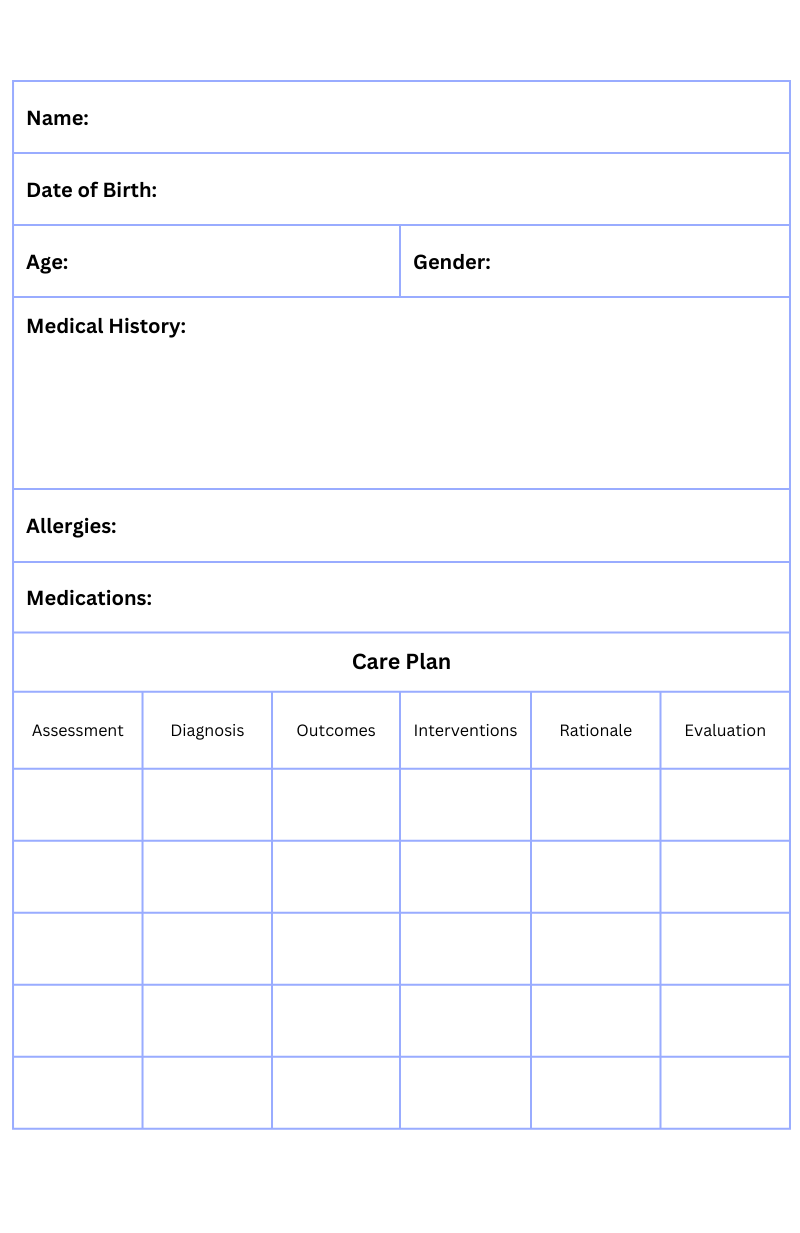A nursing care plan template is an essential tool in nursing practice. Notably, writing a nursing care plan is a necessity for both practicing nurses and nursing students.
Nurses use templates to create care plans that are designed to treat different conditions.
Whether you are writing a nursing care plan for imbalanced nutrition, nursing care plan for nausea, nursing care plan for pneumonia, or nursing care plan for urinary retention, a good nursing care plan template comes in handy.
For that reason, it is important to understand what nursing care plans entail.
What is a Nursing Care Plan?
A nursing care plan plays a central role in enhancing the quality of care provided to patients.
So, what is a nursing care plan?
In simple terms, a nursing care plan can be defined as:
A roadmap for patient care
Or
A nursing care tool that outlines the objectives and strategies pertinent to meeting the medical needs of a patient.
In this, it provides a framework for the specific care service to be delivered, including:
- Medications
- Treatments
- Procedures
- Required lifestyle changes
- Self-care strategies, etc.
A nursing care plan also stipulates the methods to assess how a patient is responding to the treatment plan.
This helps nurses to effectively track changes on the conditions of the patient and consequently enables them to intervene in time before further complications arise.
Components of a Nursing Care Plan
A good nursing care plan template has to consider all the components of a care plan.
Although nursing care plans can vary widely in their contents, it is generally accepted that they should include the following components:
1. Health assessment of the patient
This entails the medical records and diagnostic reports of the patient.
In this, the assessment should focus on areas such as physical, psychosocial, functional, sexual, cognitive, economic, cultural, spiritual, and environmental aspects of the patient.
2. Nursing diagnosis
The nursing diagnosis entails a statement outlining the health concern or an issue involving the patient. It encompasses the assessment information gathered on the health status of the patient.
3. Expected outcomes
Expected outcomes are also a key component to a nursing care plan template.
They involve the specific goals that the care plan intends to achieve through the laid out interventions.
Such goals could be both short-term and long-term.
4. Nursing interventions
These include the specific actions that the nursing care plan will take to resolve the health issue (nursing diagnosis), and by doing so achieve the expected outcomes.
The interventions must be aligned to best practices and evidence based approaches in nursing.
5. Rationales
Rationales entail evidence-based explanations for the identified nursing interventions.
They must be founded on existing and current evidence.
6. Evaluation
Evaluations are also central to a nursing care plan template.
They involve plans on how to monitor and assess a patient’s care progress and the required adjustments to the nursing care plan accounting for changes in patient’s health status and goals.
Types of Nursing Care Plans
Nursing care plans can be grouped into four categories. The use of each care plan depends on patient needs, specialty, and workplace requirements.
The nursing care plan categories include:
1. Informal nursing care plan
These care plans are not written down. Instead, they are shared verbally between the patient and their family members.
They are made in the course of care giving, specifically when addressing less serious and common conditions, e.g. dermatographia.
2. Formal nursing care plan
Formal nursing care plans are more elaborate and detailed in their contents. They are weightier and require more time when drafting.
They include in depth patient assessments, additional tests, and treatment recommendations.
The consequent records are admissible as legal documents.
3. Standardized nursing care plan
These types of care plans assume a specific nursing care plan template that can allow nurses to easily create charts that are compatible to regulatory requirements.
Such templates usually come from a healthcare institution or insurance company (in the US).
They emphasize general treatment approaches for similar conditions.
4. Individualized nursing care plans
These nursing care plans stipulate how a patient should be treated based on their specific circumstances.
They only apply to an individual’s needs. For instance, a patient with a knee bruise showing signs of bacterial infection should get an individualized care for that specific infection.
Nursing Care Plan Formats
A nursing care plan template can assume different formats.
Usually, a nursing care plan format encompasses four columns that include:
- Nursing diagnoses
- Desired outcomes and goals
- Nursing interventions, and
- Evaluation
Another format has three columns- with goals and evaluation combined in the same column.
There is also a format with five columns, which goes further to include a column with assessment cues.
Three-column nursing care plan example: risk for bleeding
This nursing care plan has three columns that include nursing diagnosis, outcomes and evaluation, and interventions.
It is the most succinct of the care plans.
| Nursing Diagnosis | Outcomes and Evaluation | Interventions |
| Inherent coagulopathy (summarized example) | Patient does not experience bleeding indicated by haematocrit and haemoglobin levels. INR and PT values remain within desired range, and heart rate and blood pressure remain within normal range. | Administer reversal agents as ordered. |
Four-column nursing care plan example: urinary retention
The four columns of this nursing care plan include nursing diagnosis, goals and outcomes, interventions, and evaluation.
It is considered the more widely used care plan.
| Nursing Diagnosis | Goals and Outcomes | Interventions | Evaluation |
| Urinary incontinence (a summary) | Patient will be able to void sufficient urine amounts | Provide the patient with routine voiding measures (normal voiding positions, privacy, sound of running water etc.) | Regularly monitor patient voiding patterns and intervals |
Student nursing care plan example: imbalanced nutrition- less than body requirements
The student nursing care plan is more detailed. A deriving nursing care plan format is usually used by nurses as a teaching tool.
| Assessment | Diagnosis | Outcomes | Interventions | Rationales | Evaluation |
| Identify presence of physical signs (integumentary) e.g. dry skin, reduced subcutaneous tissue | Malnutrition (nutritional inadequacies that need additional evaluation and treatment) | Patient will come up with personal dietary goals and a plan to achieve them | Splitting the meals into six small portions instead of three large ones | Insufficient nutrition may produce physical indicators | Periodic monitoring on weight and height. Meal and calorie tracking. |
How the Nursing Care Plan Template Works
Nursing care plan templates work in a simple and straightforward manner. The process can be described by the below steps:
1. Get a nursing care plan template
You should begin by securing a nursing care plan template. This can be done by downloading one from our repository.
2. Fill in patient information
This step entails recording patient’s information such as name, date of birth, age, and health condition. You should pay adequate attention to medical history, identified allergies, and current medications. It is important to ensure that data captured is accurate.
3. Enter patient assessment
This is another key step to filling in the nursing care plan template. It requires you to assess the needs of the patient by recording their physical, mental, and emotional health status based on nursing knowledge. You should include information on symptoms and diagnoses received by the patient.
4. Develop a care plan
This step follows a thorough assessment. You should come up with a comprehensive care plan designed to meet patient needs. Goals (short-term and long-term), medications, treatments, and other interventions should be included.
5. Implement the plan
The step entails effecting the identified interventions. Measures involved include ordering and administering medications, collaborating with other healthcare providers, and educating the patient.
6. Monitor and review
As the last step on how the nursing care plan template works, it involves monitoring the progress of the patient in relation to the set goals. The care plan should be regularly evaluated to ensure that it is current and addresses the patient’s needs. Modifications should be made to reflect changes in the health of the patient and prevailing circumstances.
Features of our Nursing Care Plan Template
Our nursing care plan template constitutes some features that make it effective in its purpose.
It has the following features.
1. Easy to use
Using the template does not require any special skills or knowledge. You can easily create a comprehensive care plan for each patient.
2. Comprehensive
The template covers all the required components of a nursing care plan. It includes different sections that make sure that all care aspects are addressed. Sections covered include medical history, current medications, and allergies.
3. Customizable
The nursing care plan template can be easily customized to meet the needs of a specific patient. The ability to adjust format, remove sections, and add extra information when needed makes it very flexible.
4. Printable and sharable
The template can be printed and shared with ease. Once complete, you can save the copies for future reference or even share it with care team members via means such as email.
Nursing Care Plan Template for Students










